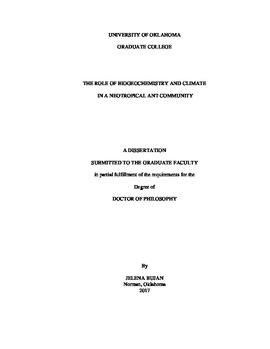| dc.description.abstract | Human activities are rapidly changing nutrient availability and climate across the globe, and this trend is predicted to continue. The effect of biogeochemistry on consumer communities is underexplored in the world’s most diverse ecosystems – the tropics. Nitrogen (N) and phosphorus (P) are leading candidates in limiting the fitness of arthropods because they are required in substantial quantities as the building blocks of numerous macromolecules, but are relatively scarce in most foods consumed by herbivorous insects. Thus, nutrient limitation of plants may negatively impact herbivores. In addition to changes in nutrient availability, climate is changing. These changes include global increases in temperature and alteration in precipitation regimes across the globe and Neotropical forests are predicted to suffer severe droughts. My work examines the role of both biogeochemistry and climate in Neotropical ants.
In Chapter One I investigate the effect of nutrient addition on the ant community of a tropical lowland forest in Panama. I used the Gigante fertilization experiment (GFP), which includes 32, 1600m2 plots that have been fertilized annually with N, P, and potassium (K) since 1998. Plants in tropical lowland rainforests grow on old, weathered soils, and tropical plant growth is typically P limited. Plots fertilized with P fertilization had higher forging activity—number of baits occupied by ants—supporting the nutrient limitation hypothesis. The same plots, however, had lower genus level diversity, consistent with the paradox of enrichment frequently observed in plant communities. Azteca was the only ant genus whose activity was higher on P plots, a pattern largely driven by one species, Azteca chartifex.
Chapter Two investigates the potential of Neotropical ants to survive water loss by comparing ant communities in two habitats with different microclimates—the canopy and the litter. The Neotropical canopy was 1° C warmer, and 9 times drier than the litter, and canopy ants had 3 times higher desiccation resistance – the ability to reduce water loss. By exploring mechanisms for the observed difference, I found that smaller ants desiccated faster given their higher surface area to volume ratio, as desiccation resistance increased with ant mass, and canopy ants were, on average, 16% heavier than the understory ants. A second way to increase desiccation resistance is to carry more water. Although water content in canopy ants was on average 2.5% higher, it was not a good predictor of desiccation resistance. Animals experiencing dry conditions are likely experiencing warm conditions as well, so I examined if critical thermal maximum (CTmax), a measure of an ant’s thermal tolerance positively co-varies with desiccation resistance. In canopy ants, desiccation resistance and CTmax were inversely related, suggesting a tradeoff, while the two were positively correlated in litter ants.
Chapter Three combines the results from the first two chapters to ask why is A. chartifex successful and dominant in this community, particularly on P plots, and yet has low desiccation resistance and CTmax for a canopy ant. The diet of A. chartifex largely includes honeydew and extra-floral nectar secretions. I predicted that workers of A. chartifex which had recently fed on this carbohydrate-rich diet, will use that energy to increase the upper limits of thermal tolerance. I used A. chartifex colonies from control and P plots from GFP where I had previously recorded higher foraging activity. As foraging activity can be governed by resource availability, I measured CTmax of field collected colonies and found that CTmax was 2° C higher in control plots than P. This difference disappeared when ants were starved. After providing colonies with a 10% sucrose solution, their CTmax increased by 5° C, supporting the hypothesis that carbohydrate nutrition allows higher thermal tolerance. This does not appear to be linked to colony trophic status, higher C:N ratios, or higher total body P. This short-term thermal plasticity linked to carbohydrate nutrition demonstrates the importance of diet in shaping physiological traits.
Chapter Four investigates the effect of biogeochemistry on A. chartifex nesting patterns across GFP. I found that N suppressed Azteca nest density, as plots which received N had 48% lower number of nests. Adding P did not affect colony abundance. The addition of both N and P significantly increased number of A. chartifex nests as well as the size of nests. The best predictor of colony size was tree size as larger trees supported larger nests. Azteca chartifex nests were non-randomly distributed, and certain tree species were preferred, despite their low frequency across the forest, while some abundant trees were avoided. Our study suggests that both nutrient availability and forest composition act in concert and help A. chartifex dominate this tropical forest.
My research finds that “bottom-up” forces shape this ant community by indirectly affecting the nest density and activity of a numerically and behaviorally dominant ant. In a rapidly warming world, carbohydrate availability and use may represent a fundamental predictor of the population and community responses of herbivorous insects in a changing world. | en_US |
